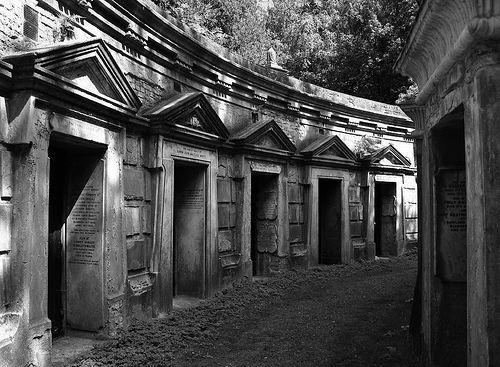Discover Highgate Cemetery
Situated within the London Boroughs of Camden, Islington and Haringey, Highgate Cemetery nestles silently within its lush woodland surroundings, whilst the hustle and bustle of city life carries on unnoticed outside its walls. Perhaps not one of the major tourist attractions within the city, it is at the very least one of the most atmospheric. The older part of the cemetery is now closed to visitors and access is granted only to those who join one of the regular guided tours, the newer part of the cemetery, where one of its more famous residents, Karl Marx, is interred, is still in use and easier to access.

Highgate History and Publicity
Originally opened in 1839 Highgate Cemetery was part of a programme designed to ease the stresses on inner city graveyards, many of which had become overcrowded and were becoming severe health hazards to surrounding residential areas. The initial design for the cemetery was drawn up by architect Stephen Geary, and it soon became a very desirable if not fashionable place to be buried, becoming quite the attraction for London’s Victorian population. The Victorians had a macabre fascination with death; mourning jewellery from the period alone is testament to that, but on a much larger scale Highgate Cemetery became a showcase of Gothic architecture and ornate tombs the like of which cannot be found in any other graveyard in the country.
It was perhaps the Gothic facade of the mausoleums within its walls that lead to the belief that the cemetery housed a vampire. Purported to be the un-dead persona of a Romanian (Wallachian) nobleman, who had been interred in the area before the cemetery was built. In March 1970 the story lead to a public invasion of the cemetery to participate in a vampire hunt. Every cemetery has its ghost stories and Highgate is no exception. Apart from its previously mentioned resident vampire the area has been the site of numerous reports of ghostly apparitions. Though accounts vary, popular descriptions include a woman in white, a ghostly cyclist and a face glaring out from behind a locked gate.
Features
The older part of the cemetery has been left in part to the mercies of the natural environment, the woodland has moved in and moss and lichen have dressed the stones in cloaks of rich green velvet. The Egyptian Avenue and Circle of Lebanon house tombs that have been carved into the hillside, though some may now be cracked and aged they still show the splendour and pride of a bygone age. Mausoleums stand proud, their stained glass reflecting their original splendour whilst visitors break the silence of the dead with their whispers and footfalls.
The Friends of Highgate Trust have maintained both parts of the cemetery since 1975 and offer regular guided tours, pointing out the tombs of their most famous residents and providing visitors with a wealth of knowledge about the site. Photography is permitted within the cemetery although images may not be published without written permission.

